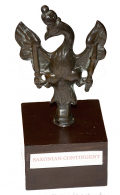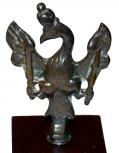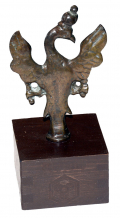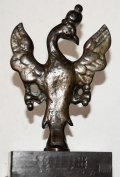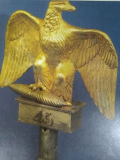site search
online catalog
EXTRAORDINARILY RARE NAPOLEONIC CAVALRY STANDARD EAGLE
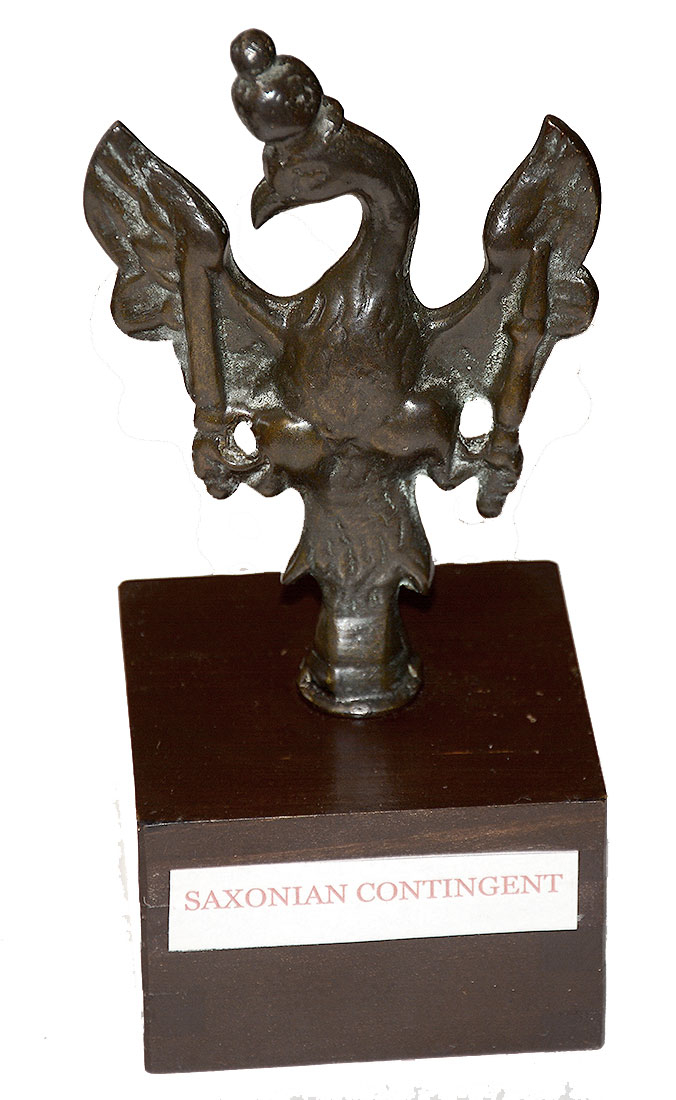
$1,250.00
Quantity Available: 1
Item Code: 88-222
This solid cast bronze Saxonian eagle was unearthed decades ago in Russia at the notorious Berezina River crossing. "On the 19th October, 1812, Napoleon's Grande Armée left Moscow and began its miserable retreat. A month later, on 25 November, 1812, it arrived at the Berezina River, which barred its progression to the west. Under attack from the Russians, the army escaped destruction thanks to the sacrifice of the pontonniers of general Eblé who constructed two bridges which allowed the major part of the army to cross the river on 27 and 28 November. The following day, the Grande Armée was forced to abandon its positions and decided to destroy the bridges, abandoning nearly 10,000 men, women and children on the eastern bank of the river. The term “Berezina” has since entered the French language as a synonym for disaster, in reference to the 25,000 combatants and 30,000 non-combatants who were killed. The battle was nevertheless a tactical victory for Napoleon, who managed to get his army out of a potentially fatal situation". This Kingdom of Saxony Eagle was designed to sit atop the pole of a cavalry standard or guidon. After 1806 the Kingdom of Saxony was allied to Napoleon and Frederick Augustus was also named Duke of Warsaw. Frederick Augustus pledged Napoleon 20,000 men with thousands to follow. They maintained their newly designed flags (see attached) and heraldic insignia but downed French arms and uniforms.
The Saxonian Army fought honorably for Napolean and in 1812 a large contingent marched with the Grande Armee into Russia. The main forces of the Saxonian army were part of the VII Corps under General of Division Reynier accompanied by French and Austrian forces. These contingents operated near Brest, with the Saxon forces being the first to be defeated by the Russians at the humiliation in the Battle of Kobryn where an entire brigade was defeated. Though this strategic blunder was somewhat mitigated when Austro-Saxon troops managed to inflict a defeat on the Russian forces in the Battle of Gorodechno a month after. Some units of the Saxon army were attached to various other corps or garrisons, with the Garde du Corps and Zastrow cuirassiers becoming renowned for their action in the Battle of Borodino. Majority of the Saxon army was destroyed during the campaign and the state faced a difficult crisis as the main front of the fighting moved to Saxony proper in the following year.
The eagle measures 5 inches in height with a wingspan of 3 1/2 inches. It has a 3/4 of an inch threaded iron rod which would have screwed into the top of a regimental or company flagpole. It sits on a newly made wooden 3 x 3 x 2 plinth. The patina is rich, and the condition is perfect. This sword and sceptered "Saxonian/Duchy of Warsaw" Eagle was designed in 1806 and discontinued after the final defeat of Napoleon. For about $500,000 you can buy, if you can find one, an Eagle cast by Thomire for the regimental banners of Napoleon's Grand Armee . "The original design was sculpted by Antoine-Denis Chaudet and then copies were cast in the workshop of Pierre-Philippe Thomire, with the first eagles presented on 5 December 1804." Or you can buy this one that was also "there" and lost on the Retreat from Moscow for thousands less! [pe][ph:L]
~~~~~~~~~~~~~~~~~~~~~~~~~~~~~~~~~~~
THIS ITEM, AS WITH ALL OTHER ITEMS AVAILABLE ON OUR WEB SITE,
MAY BE PURCHASED THROUGH OUR LAYAWAY PROGRAM.
CLICK HERE FOR OUR POLICIES AND TERMS.
THANK YOU!
Inquire About EXTRAORDINARILY RARE NAPOLEONIC CAVALRY STANDARD EAGLE
For inquiries, please email us at [email protected]
Most Popular
Historical Firearms Stolen From The National Civil War Museum In Harrisburg, Pa »
Theft From Gravesite Of Gen. John Reynolds »
Selection Of Unframed Prints By Don Troiani »
Fine Condition Brass Infantry Bugle Insignia »
British Imported, Confederate Used Bayonet »
Scarce New Model 1865 Sharps Still In Percussion Near Factory New »
featured item
MODEL 1841 NAVAL OFFICER’S SWORD IDENTIFIED TO SIMON BACKUS BISSELL
Simon Backus Bissell was born in Fairlee, Vt., on October 28, 1808. He was appointed Midshipman on November 6, 1824, Passed Midshipman on June 4 1831, and Lieutenant December 9, 1837. At the beginning of the Mexican-American War, he was assigned to… (870-63). Learn More »



